Products: ABAQUS/Standard ABAQUS/Explicit
Applications of the *TEMPERATURE, *FIELD, and *PRESSURE STRESS options are tested. The first set of tests verifies that temperature and field variable data are properly transferred from a heat transfer analysis to a structural analysis using the results file for various combinations of the *TEMPERATURE and *FIELD options. The second set of tests verifies the use of these commands in conjunction with composite structural shells. The third set of tests verifies the interpolation of temperatures to the midside nodes in a sequential thermal-stress analysis, when the heat transfer analysis is carried out using first-order elements and the stress analysis is carried out using second-order elements. The fourth set of tests verifies that temperatures are properly interpolated between dissimilar meshes. Heat transfer models and stress analysis models may have dissimilar meshes, and the nodal temperatures for the current model will be interpolated from the nodal temperatures from the heat transfer model. The fifth set of tests verifies that temperatures and pressures are properly defined using data line input for various combinations of these two commands. The fifth set of tests verifies that a solution-dependent variable from a heat transfer analysis is properly transferred as a field variable into a stress analysis.
In several of the tests zero-increment results file output is requested using the *FILE FORMAT, ZERO INCREMENT option. This output is used to define initial values of temperature, field variables, and pressure stress for subsequent structural analyses.

These tests verify that temperature and field variable values are properly transferred to a structure when various combinations of *TEMPERATURE and *FIELD are used. The structure being analyzed is a cantilevered truss made up of 10 T3D2 elements.
Three different transient heat transfer runs are used to generate three results files containing temperature histories. These files will be read into subsequent stress analyses as either temperature or field variable data. All of the runs begin with the entire truss at some initial temperature; the temperature throughout the truss is then ramped to some new temperature.
The three heat transfer runs are as follows:
xtfvtrt1.inp
Initial temperature: 100
Final temperature: 200
xtfvtrt2.inp
Initial temperature: 200
Final temperature: 250
xtfvtrt3.inp
Initial temperature: 200
Final temperature, Step 1: 180
Final temperature, Step 2: 100
The subsequent stress analysis runs are as follows:
xtfvtrs1.inp
This file tests the setting of temperature and more than one field variable using results files. Temperature and two field variables are set by reading the data from the results files of the heat transfer runs as follows:
xtfvtrt1.fil ![]() Temperature
Temperature
xtfvtrt2.fil ![]() Field variable 1
Field variable 1
xtfvtrt1.fil ![]() Field variable 2
Field variable 2
xtfvtrs2.inp
This file tests the setting of a field variable from a results file without temperature being present in the problem. This test is important because of the way that temperatures and field variables are stored internally. The field variable is set by reading the data from the results file of the first heat transfer run as follows:
xtfvtrt1.fil ![]() Field variable
Field variable
xtfvtrs3.inp
This file tests the presence of temperatures and field variables when initial condition specifications are present for variables that are not used in the analysis. Initial conditions are given for temperature and two field variables, and then only temperature and the first field variable are set by results files. In addition, two *FIELD options are included for the same field variable to test that only the last command is used. Temperature and the field variable are set by reading the data from the results files of the heat transfer runs as follows:
xtfvtrt1.fil ![]() Temperature
Temperature
xtfvtrt2.fil ![]() Field variable 1
Field variable 1
xtfvtrs4.inp
This is a three-step problem involving temperature and one field variable. In the first step an amplitude curve is used to set the temperature to 200 and the field variable to 250. In the second step the temperature is ramped down to 150, and the field variable is defined by the results file from xtfvtrt2.fil. In the third step both the temperature and the field variable are reset to their initial conditions.
The following must be confirmed by this test:
Temperatures and field variables must be set correctly using an amplitude curve.
Initial conditions must be ignored if temperatures and field variables are set using an amplitude curve.
Results file data must be scaled properly in time if the stress analysis time period is different from the heat analysis time period.
If commands are given to read temperature/field variable data both from data lines and from a results file, the data line input must take precedence.
If the OP parameter is given with a value of NEW, temperatures/field variables must be ramped back to initial conditions or set to the new values defined on the data lines.
xtfvtrsr.inp
This analysis restarts xtfvtrs4.inp from the third step. Two additional steps are performed. In the first step the temperature is set by reading the results file from xtfvtrt1.fil, and the field variable is set by reading the results file from xtfvtrt2.fil. In the second step the temperature is set using the data from the second step of the results file from xtfvtrt3.fil.
xtfvtrs5.inp
This run tests the BSTEP, BINC, ESTEP, and EINC parameters on the *TEMPERATURE and *FIELD options. Temperature and two field variables are set by reading the data from the results files of the heat transfer runs as follows:
xtfvtrt1.fil ![]() Temperature, BINC=1, EINC=5
Temperature, BINC=1, EINC=5
xtfvtrt2.fil ![]() Field variable 1, BINC=5, EINC=8
Field variable 1, BINC=5, EINC=8
xtfvtrt1.fil ![]() Field variable 2, BINC=6, EINC=10
Field variable 2, BINC=6, EINC=10
All data are read from Step 1, so BSTEP and ESTEP are both 1 in all cases.
The exact solution to the heat transfer problems (xtfvtrt1.inp, xtfvtrt2.inp) consists of a linear temperature history. Temperature is uniform throughout the structure at each point in time. The solution given by ABAQUS matches the exact solution.
The only quantity of interest in the stress analysis runs is the temperature in the structure. Expected solutions are shown in Figure 5.1.24–1 through Figure 5.1.24–5.
Truss, heat transfer, first run.
Truss, heat transfer, second run.
Truss, heat transfer, third run.
Truss, stress analysis, first run.
Truss, stress analysis, second run.
Truss, stress analysis, third run.
Truss, stress analysis, fourth run.
Truss, stress analysis, restart.
Truss, stress analysis, fifth run.

Figure 5.1.24–1 Temperature and field variables for xtfvtrs1.inp.
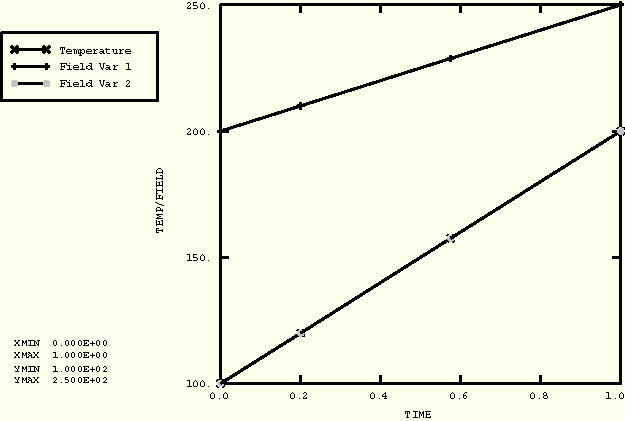
Figure 5.1.24–2 Field variable for xtfvtrs2.inp.
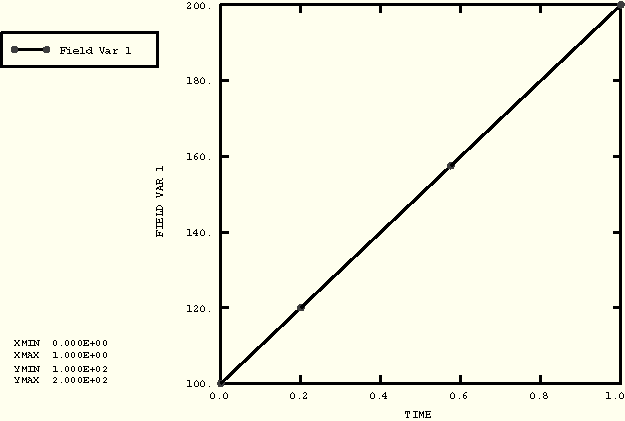
Figure 5.1.24–3 Temperature and field variable for xtfvtrs3.inp.
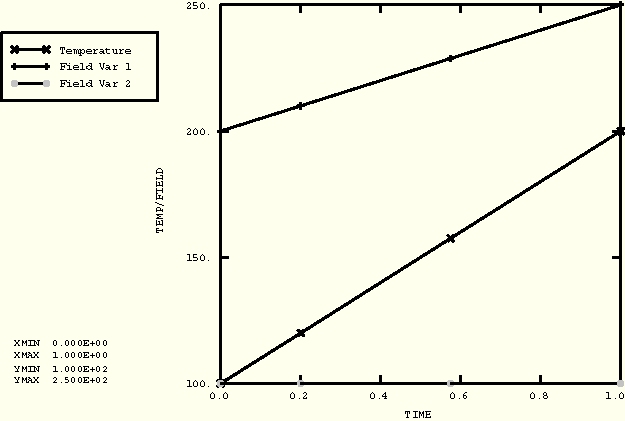
Figure 5.1.24–4 Temperature and field variable for xtfvtrs4.inp and xtfvtrsr.inp.
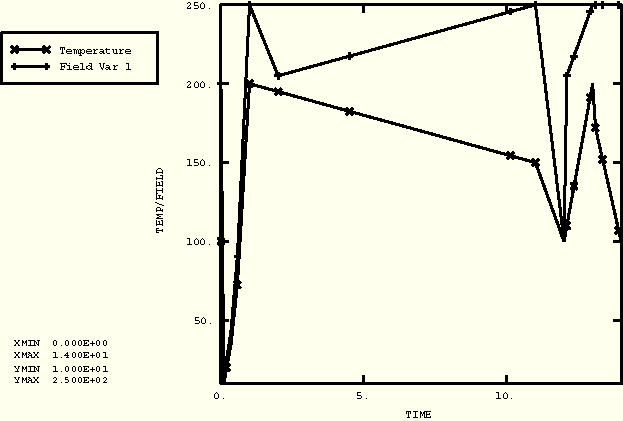
Figure 5.1.24–5 Temperature and field variables for xtfvtrs5.inp.
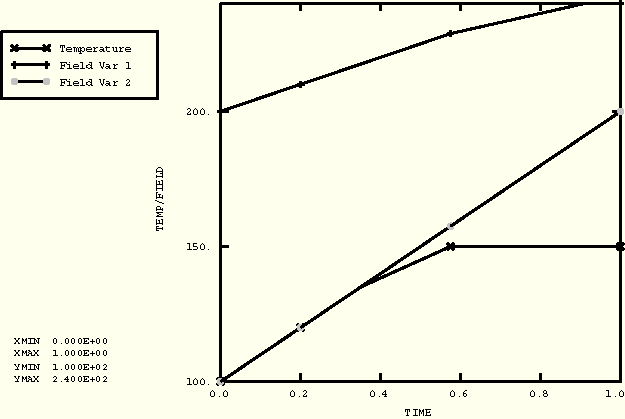

These tests verify the use of *TEMPERATURE and *FIELD in conjunction with composite structural shells. Both temperature and field variable results are generated from a single previously run heat transfer shell analysis. The same analysis can be used for generation of field variable results, since field variables are stored identically to temperatures in an ABAQUS results file.
The heat transfer problem involves a three-layer composite shell that is subjected to prescribed thermal boundary conditions on its top and bottom surfaces. A steady-state analysis is performed to obtain the temperature distribution through the thickness of the composite layers. Three temperature points are used for each layer. The temperature distribution obtained is compared to the exact solution.
In two subsequent runs the temperature results are fed into a similar structural model using the *TEMPERATURE and *FIELD options. Five section points per layer are chosen for the structural model. The temperatures and field variables are assigned to these five points through a linear interpolation of the three values available per layer from the preceding heat transfer analysis. The results of these analyses verify that the temperatures and field variables are assigned properly.
This sequence of runs is tested for shells with 3, 4, 6, and 8 nodes.
The heat transfer run matches the exact solution for the temperature distribution through the composite shell layers. In addition, these values are transferred properly to the structural composite shell as either temperature or a field variable.
The temperature/field variable at the bottom of layer 1 is 425°.
The temperature/field variable at the top of layer 1 and the bottom of layer 2 is 373.2°.
The temperature/field variable at the top of layer 2 and the bottom of layer 3 is 336.8°.
The temperature/field variable at the top of layer 3 is 287.5°.
Heat transfer analysis; DS3 elements.
Stress analysis; temperature results; DS3 elements.
Stress analysis; field variable results; DS3 elements.
Heat transfer analysis; DS4 elements.
User subroutine FILM used in xtmpcst4.inp.
Stress analysis; temperature results; DS4 elements.
Stress analysis; field variable results; DS4 elements.
Heat transfer analysis; DS6 elements.
Stress analysis; temperature results; DS6 elements.
Stress analysis; field variable results; DS6 elements.
Heat transfer analysis; DS8 elements.
Stress analysis; temperature results; DS8 elements.
Stress analysis; field variable results; DS8 elements.

These tests verify the interpolation of temperatures to the midside nodes of higher-order elements in a sequential thermal-stress analysis, when the heat transfer analysis is performed using first-order elements and the stress analysis is carried out using second-order elements.
The results of the heat transfer analyses are read into the stress analyses using the *TEMPERATURE, MIDSIDE, FILE=option. Similarly, the initial conditions applied to the heat transfer analysis are read into the stress analyses using the *INITIAL CONDITIONS, TYPE=TEMPERATURE, MIDSIDE, FILE= option. The MIDSIDE parameter in both the options indicates that the temperatures at the midside nodes must be interpolated from the corner nodes of the element. Temperature interpolation is carried out on an edgewise basis for each element. Thus, the temperature at the midside node of an element is interpolated linearly from the temperatures at the corresponding corner nodes.
The midside node temperature interpolation is tested for one-dimensional, two-dimensional, and three-dimensional elements.
Only one element is used in the finite element models for both heat transfer analysis and stress analysis. Arbitrary material properties are assumed.
The results of the stress analysis with higher-order elements compare well with those obtained with linear elements.
DC1D2 elements.
DC2D3 elements.
DC2D4 elements.
DC3D4 elements.
DC3D6 elements.
DC3D8 elements.
C3D10 elements.
C3D10M elements.
C3D15 elements.
C3D20 elements.
CPE6 elements.
CPE6M elements.
CPE8 elements.
T2D3 elements.
C3D10M elements.
CPE6M elements.
The input files for the stress analyses with linear elements can be generated by suitably replacing the element type in the above files.

These tests verify the interpolation of temperatures between dissimilar meshes. This capability is available only for use with the output database file. The INTERPOLATE parameter must be used on the *INITIAL CONDITIONS, TYPE=TEMPERATURE, FILE= or the *TEMPERATURE, FILE= option. For the cases where the only dissimilarity is an element order, the MIDSIDE parameter should be used. However, for the purpose of verification we reused some of the models created for the midside cases.
The results of the heat transfer (or coupled temperature-displacement) analyses are read into the stress analyses. The INTERPOLATE parameter on the *INITIAL CONDITIONS, TYPE=TEMPERATURE and the *TEMPERATURE options indicates that the temperatures must be interpolated from the nodes of the element in the heat transfer models to the nodes of the current stress analysis models.
The interpolation technique is tested for two-dimensional and three-dimensional elements.
The temperature distribution in the stress analysis models compares well with that obtained in the heat transfer (coupled temperature-displacements) models.
C3D8HT elements. NT field written to the output database.
C3D8H elements. Static analysis with the temperature field interpolated from psc38ths_inter.inp.
DC2D3 elements.
DC2D4 elements.
DC3D4H elements.
DC3D6H elements.
DC2D4 elements.
DC3D8, DC3D10 elements.
C3D10 elements.
C3D10M elements.
C3D15 elements.
CPE6M elements.
C3D8 elements.
CPE8 elements.
CPE4 elements.
CPE4 elements, multistep, static analysis.
CPE4 elements, restart analysis.
C3D10M elements.
CPE6M elements.

These tests verify that temperatures and pressures are applied properly to a structure when various combinations of *TEMPERATURE and *PRESSURE STRESS are used in a *MASS DIFFUSION analysis. Temperature and pressure stress initial conditions are read from the results file of an ABAQUS/Standard analysis, and a series of pressure and temperature loadings are applied to the nodes of an element using data line input in the following sequence:
Step 1: Concentration ramped from 0 to 100 at a corner of the element.
Step 2: A pressure gradient is applied along one diagonal of the element.
Step 3: All pressures are reset to initial conditions with OP=NEW.
Step 4: A temperature gradient is applied along the same element diagonal as the pressure gradient in Step 2.
Step 5: All temperatures are reset to initial conditions with OP=NEW.
Step 6: Pressure and temperature gradients are applied simultaneously along the element diagonal.
The material properties of the problem are defined such that
![]()
The following must be confirmed by this test:
Pressures must be set correctly using an amplitude curve.
If OP=NEW, temperatures/pressures must be ramped back to their initial conditions or set to the new values defined on the data lines.
The results match the exact analytical solutions for the applied temperature and pressure gradients.
This analysis generates a results file with temperature and pressure stress data, which is used to define initial conditions in xpresspt.inp.
This file tests the setting of temperature and pressure using data line input, as outlined earlier.
This analysis restarts the second step of xpresspt.inp from increment 2. Results at the end of the analysis should be identical to the results at the end of the second step in xpresspt.inp.

These tests verify that the solution-dependent variables from a heat transfer analysis are properly transferred as field variables in the subsequent stress analysis. The structure being analyzed is a cantilevered truss made up of 10 one-dimensional link elements. Output variable SDV is written to the results file using the *EL FILE, POSITION=AVERAGED AT NODES option. A separate results file is then generated, where the SDV value is stored as the second attribute under record key 201.
The temperature and field variable values are set by reading the data from the results file of the heat transfer run as follows:
xsdvttrt.fil ![]() Temperature
Temperature
xsdvttrt1.fil ![]() Field variable
Field variable
The solution-dependent variable is transferred correctly into the stress analysis as a field variable.
Heat transfer analysis.
User subroutine HETVAL used in xsdvttrt.inp.
Stress analysis.
Postprocessing program.